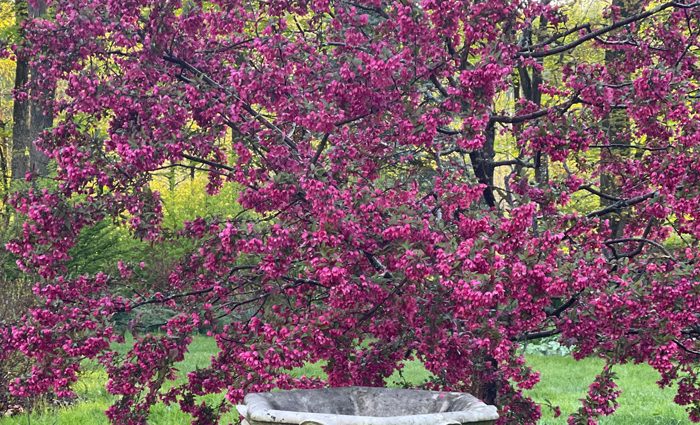designed for the way women work.

What causes good years and bad years for flowering trees and shrubs?
Category: Presenting "The Curious Gardener"
Last year the ornamental cherry tree on my property had the most glorious blooms and this year it didn’t. The same with my lilacs. On the other hand, my crabapples bloomed beautifully this year but last year they were so-so, and I expect they will be so-so again next year. Many trees and shrubs need a “rest” year.
Some of this is part of the mystery of nature, but often there are other explanations for why our trees and shrubs have good years and bad years, some which we can control and some which we can’t. After consulting with horticulturist Ruth Clausen we came up with these 6 reasons.
Pruning
Ill-timed pruning is one of the leading reasons that shrubs don’t bloom. The time to prune flowering shrubs is just after they bloom. If you prune spring bloomers before they flower you will be cutting off this year’s buds. But don’t wait too long to prune after the flowers have faded, as next year’s flower buds develop during this year’s growing season. Lilacs, azaleas, rhododendrons and forsythia fall into this category. In the case of lilac, you can remove up to a third of the shrub each year to encourage new growth. Since I haven’t done that in a few years, I think that may be one of the reasons my lilacs failed to bloom profusely this year.
Shrubs that flower later in the season usually bloom on new wood that develops after a light pruning in fall or early spring. Spirea, Caryopteris, Hibiscus, summersweet, and smoke bush are good examples. In cold winter regions, it’s best to prune late bloomers in spring rather than fall.
Hydrangeas are famous for mysteriously refusing to produce blossoms. But hydrangeas have many species and each has its own pruning requirements. Species such as H. paniculata and H. arborescens (along with their hybrids) like to be pruned hard in spring, as they bloom on this year’s new growth. H. macrophylla (bigleaf or mophead hydrangeas) bloom on growth made the previous growing season, so deadhead after bloom time, just to a lower leaf bud on the stem. This encourages a further crop of flowers as well. Wait until early fall to prune or shape the plants hard.
Browsing Deer
If deer are eating next year’s buds, you won’t have flowers next year on that shrub or young tree. Most healthy shrubs that are eaten by deer one year will come back the next year. If they’re eaten two years in a row they may not. These shrubs are considered deer-resistant (NOT deer-proof): viburnums, caryopteris, forsythia, lilac, magnolias.
Weather
Weather can affect fruit and flower production if it hits at just the wrong time. For instance, a cold snap just when buds are developing might kill them. A period of intense heat and drought just when the buds are developing for next year can affect next year’s blossoms. Poor drainage or too much water can put stress on a tree or shrub too.
A cooler spring, as we’re having in my Zone 6 region this year, will keep flowers on trees and shrubs fresh longer. A wet, warm spring leads to flowers fading and falling off faster.
Longer Term Climate Change
Warming temperatures have caused some species to expand their range northward. These include peach trees, which need a chilling period to produce fruit, and hemlock trees. Some plants are expanding their natural range as they are better able to survive further north than in the past.
Alternate Bearing
Some fruit trees bear best every other year, because of the energy it takes to produce fruit. If this is a fruit bearing year flower development may be slower, which affects next year’s crop. One way to discourage alternate bearing is to hand thin the developing fruit, spacing them 8 to 10 inches apart on the branches within 6 weeks of blooming. This applies to apples, pears, apricots and peaches.
Mast years
If you have noticed that some years your oak trees produce a bumper crop of acorns and some years they don’t, the explanation is that some trees, such as oak, hickory and beech, have what’s called mast years. This is when an abundance of seeds is produced. Some theorize that spreading their seed is their way of perpetuating the species. Following a mast year the population of deer, chipmunks, mice and squirrels increases. Raspberries and blueberries can also have mast years.
In conclusion, as Ruth says, when you have a good year, just appreciate it!
Click here to read more about Ruth Clausen, author and horticulturist.



Always enjoy your articles!
Thank you for articles that inform on topics that are not usually covered in other gardening sources – very much appreciated!
I’d better get out there and prune the lilacs!